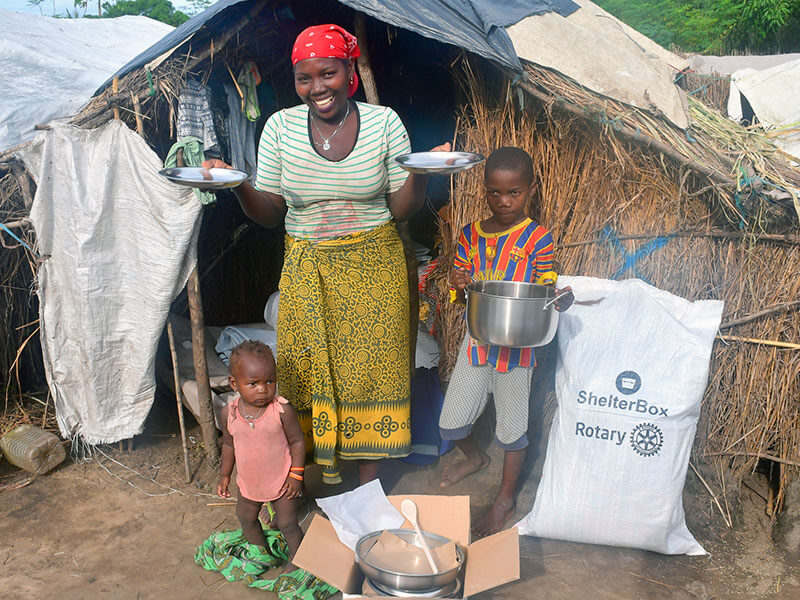Where we're working
Get the latest updates from the field and discover where we’re supporting communities around the world in the aftermath of disaster and conflict.
Every family deserves a place to call home after disaster.
We work with disaster-affected communities to provide the emergency shelter, essential items and training needed to support families in the long process of rebuilding their lives.
Every disaster is different so we have a flexible approach. We listen and learn from the communities we work with to make sure we provide the right support.
We often go further, working with hard to reach communities who are overlooked by others.
Before a disaster happens, we make sure we are ready to help. We store aid in strategic locations around the world so we can get it to the families who need it as quickly as possible.
We work with trusted local partners and we have a network of incredible volunteers who are ready to help at a moment’s notice.
Our teams can travel by foot, boat, or helicopter to get to the families who need your support – whatever it takes to get to the people who need us.
Learn more about how it all happens.
Get the latest updates from the field and discover where we’re supporting communities around the world in the aftermath of disaster and conflict.
Discover the aid items that you provide to help families rebuild their lives
How we work with local partners, organizations, and Rotary Clubs to get your aid to the families who need it most.
Recovery starts with shelter. Having somewhere dry and warm to sleep, to prepare meals and be with your family is vital for starting the long process of rebuilding your life.
Emergency shelter offers privacy and helps to preserve your dignity. It offers protection from the elements, animals and disease. It helps keep communities together. It can help to bring back a sense of normality, allowing children to go back to school.
Most importantly, it empowers families to start the process of getting back on their feet.

Our work doesn’t stop once we have provided families with emergency shelter and essential aid items.
We also offer comprehensive training to make sure families can make the best use of the items.
We use a train-the-trainer approach to empower communities to rebuild and maintain their homes long after our teams leave.
It’s not just about teaching people to construct shelters as quickly as possible. It’s about making the most of the aid items, so that families have the best possible chance of recovery.
Wherever possible we go back to visit families and we ask questions to understand how helpful our support has been. This means we can keep on learning and improving the support that we give.
We are committed to seeing a world where no family goes without shelter after disaster and we help as many families as we can.
But we are a charity with limited resources and knowing who, where and when we can help can be hard. Take a look at our response criteria which helps us decide when we can help.

We are committed to seeing a world where no one is without shelter after disaster and we help as many families as we can.
But we are a charity with limited resources and knowing who, where, and when we can help can be hard.
Take a look at our response criteria which helps us decide when we can help.
Our highly trained ShelterBox response teams are always ready.
Many are volunteers who train alongside members of staff and take time out from their own families and jobs to help other families around the world when disaster strikes.
They play a crucial role in getting our aid to the families who need it most – but they do so much more than that. They get to know communities and work with local people to understand what’s needed and support families in making the most of the items provided. They think on their feet to solve logistical issues and they work with local governments and partners to support as many people as possible.

Our new Theory of Change sums up what we will do and why to support communities affected by crisis. It builds on our 20+ years of experience and on the latest evidence of the vital role shelter can play in enabling people to recover and rebuild.
Our focus is on self-led recovery. However, we know that growing numbers of vulnerable people are unable to recover without support.
This leaves them more vulnerable to other risks, such as disease, poverty and environmental threats like extreme weather events. Our Theory of Change commits us to accompanying people on their first steps to recovery, because this increases their chances of further rebuilding their lives.
~~~
Click on the image to see a larger version of our “How your support makes a difference” page.
When disaster strikes, every second counts. That’s why our pre-positioned aid makes such a huge impact, because we can get there even faster by being prepared.
The term ‘natural disasters’ is commonly used – but disasters are not natural. Here are five reasons why.
Read how ShelterBox is committed to reducing unnecessary single-use plastic from our aid packaging.